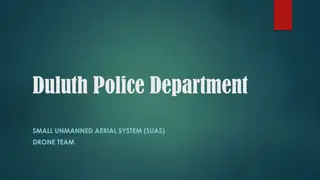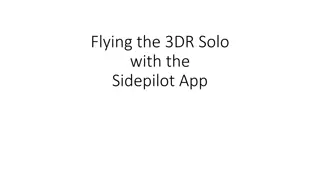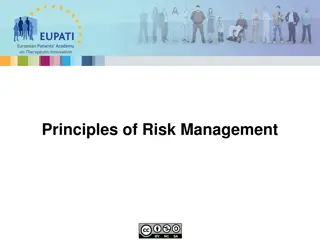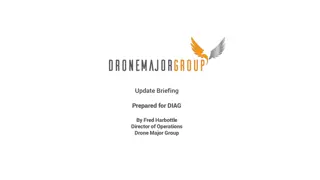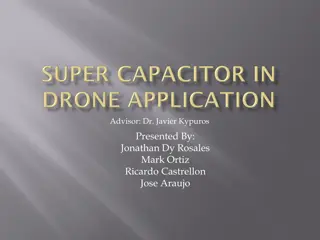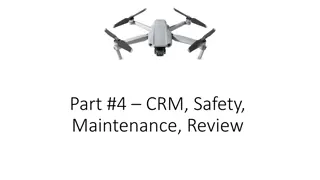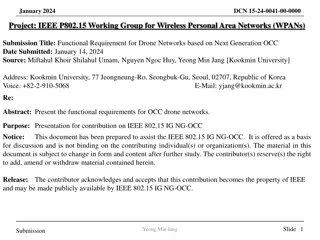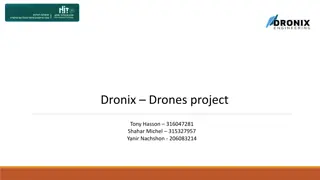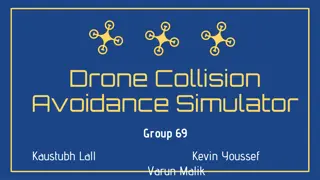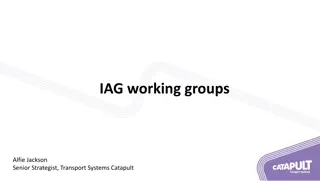Risk Management Plan for Drone Operations
This document outlines a comprehensive risk management plan for drone operations, covering areas such as operational zones, probability assessment, severity definitions, and specific risks like rotor damage in flight. Detailed maps and mitigation strategies are provided to ensure safe and effective drone missions.
Download Presentation

Please find below an Image/Link to download the presentation.
The content on the website is provided AS IS for your information and personal use only. It may not be sold, licensed, or shared on other websites without obtaining consent from the author.If you encounter any issues during the download, it is possible that the publisher has removed the file from their server.
You are allowed to download the files provided on this website for personal or commercial use, subject to the condition that they are used lawfully. All files are the property of their respective owners.
The content on the website is provided AS IS for your information and personal use only. It may not be sold, licensed, or shared on other websites without obtaining consent from the author.
E N D
Presentation Transcript
FRR for Name of Project Date of FRR submission Name of Requestor
Operational Area Operational Area Description. Add detailed map TEMPLATE (WRITE IN ALL CAPS) / 2
Operational Area Detailed map with flight area, pilot location, spotter locations, launch/landing area and no flight zones TEMPLATE (WRITE IN ALL CAPS) / 3
Risk Management - Probability Qualitative or quantitative assessment, as feasible Time basis is full aircraft design lifetime [x]-hour design livetime Assess probability as if planned project activites continued for entire lifetime of system Probability Definition If this test went on for the entire life of the system, this hazard would occur on a regular basis. A. Frequent If this test went on for the entire life of the system, this hazard would occur multiple times, though only on a minority of individual operations. B. Occasional If this test went on for the entire life of the system, this hazard would occur at least once. C. Likely If this test went on for the entire life of the system, this hazard would be expected to not occur at all, though its occurrence is possible. D. Unlikely Physically-possible, but sufficiently unlikely that to expect its occurrence could be considered irrational. E. Remote FRR Template 3.2024 / 4
Risk Management - Severity Severity Definition Crew/ Test Team Uninvolved Persons Aircraft/System Other Property Loss of manned aircraft; or loss of UAV with value > $1M Loss of facility or expensive/unique system I. Catastrophic Loss of life Loss of life; or Severe/permanent injury Minor injury (medical treatment requiring no lost work days, and no permanent injury) Severe manned aircraft damage; or loss of UAV with value > $250k Severe equipment or property damage II. Critical Severe/permanent injury No injury potential Minor manned aircraft damage; or Severe damage to UAV with value > $250k; or loss of UAV with value up to $250k Minor equipment or property damage III. Minor Minor injury (medical treatment requiring no lost work days, and no permanent injury) No injury potential Minor damage insufficient to compromise project objectives Incidental damage comparable to normal wear- and-tear IV. Negligible Superficial injury (first aid may be required) FRR Template 3.2024 / 5
Risk 1: Rotor Damage in Flight Description: Unanticipated interaction of drone with stationary object, resulting in damage or destruction of rotors. Effect: Automated flight correction allows flight with moderately damaged rotors. Automated flight abort occurs if correction cannot be automatically applied, resulting in uncontrolled landing. Emergency Procedures: If uncontrolled landing occurs, spotters begin recovery operations to collect all components of system from landing site. Mitigations: Ensure all flight operations occur within acceptable environmental conditions. Ensure all flight operations occur in clear areas with ample space. Constant monitoring of conditions by spotters. Severity: Minor (III) Little possibility of injury, with complete drone replacement price under $2000. Probability: Unlikely (D) When operated within proper guidelines, this event should be completely avoidable. FRR Template 3.2024 / 6
Risk 2: Battery exhaustion during flight Description: Unanticipated depletion of battery to critical levels during flight. Effect: Drone performs automated emergency landing procedure. Emergency Procedures: Spotters maintain visual contact with UAS as it performs emergency landing. Spotters proceed to landing location and begin recovery operations. If touchdown occurs among seals, our trained personnel will initiate recovery. Mitigations: Ensure flight only occurs on fully charged batteries. Ensure landing procedures begin early with a robust battery level buffer. Constant monitoring of UAS by spotters. Severity: Negligible (IV) Little possibility of injury or damage to UAS. Probability: Unlikely (D) When operated with proper battery procedure, this event should be completely avoidable. FRR Template 3.2024 / 7
Risk 3: GPS data link loss Description: Loss of GPS connection to drone. Effect: UAS can no longer perform autonomous flight capability. Emergency Procedures: Manual control is assumed and drone is piloted to the designated landing area for touchdown. Mitigations: Ensure the UAS has a sufficient GPS connection before all flights commence. Ensure all flights occur within visible range of operator. Severity: Negligible (IV) With manual control still available, landing procedures will continue normally and no damage is expected to occur to personnel or the aircraft. Probability: Unlikely (D) When operated within proper guidelines, loss of GPS connection is not a common occurrence. FRR Template 3.2024 / 8
Risk 4: Loss of manual control Description: Equipment malfunction resulting in total loss of manual UAS control. Effect: Drone detects loss of data link and assumes automated control and landing procedures. Emergency Procedures: The UAS is equipped with an automated return to home function in the event of this happening. The system will return to its point of origin and commence an automated landing procedure. Mitigations: Ensure functionality of remote-control equipment before any flights occur. Landing area will remain clear of obstacles or personnel for the duration of the flight. Severity: Negligible (IV) As the drone is equipped to address this situation, the most likely outcome is a safe landing performed autonomously. This will result in no injury to personnel or equipment. Probability: Unlikely (D) Rigorous testing of equipment and software of the system by the manufacturer ensures this event is uncommon. FRR Template 3.2024 / 9
Risk 5: Total loss of all signal to UAS Description: UAS loses all signal from both the operator and GPS due to unknown interference. Effect: UAS enters standby mode and maintains altitude. The unit will eventually perform automated landing when battery levels are critical. Emergency Procedures: Spotters maintain visual contact with the drone as the operator attempts to re- establish connection. In the event of wind carrying the drone, spotters will attempt to follow and maintain visual contact. Mitigations: Ensure all flight operations occur within acceptable environmental conditions. Ensure all operation occurs within visual range of operator and spotters. Severity: Minor (III) Little possibility of injury, with complete drone replacement price under $2000. Probability: Remote (E) As loss of GPS connection and loss of manual control individually are both unlikely events, the probability of these errors occurring simultaneously is extremely low. FRR Template 3.2024 / 10
Risk Assessment Matrix Put each Risk into it s respective box Mishap Severity Category I. II. III. IV. Catastrophic Critical Minor Negligible Extra Treatment needed for High Risk A. Frequent B. Occasional Extra Treatment needed for Medium Risk Mishap Probability Category C. Likely No more treatment needed for Low Risk D. Unlikely E. Remote TEMPLATE (WRITE IN ALL CAPS) / 11
Emergency Procedures Describe what emergency procedures will be in place convallis. Duis ut diam quam nulla porttitor massa id neque. Vestibulum mattis ullamcorper velit sed. Senectus et netus et malesuada fames ac. Risus nullam eget felis eget. Sit amet volutpat consequat mauris nunc. Libero id faucibus nisl tincidunt. Pharetra massa massa ultricies mi quis. Quis viverra nibh cras pulvinar mattis nunc sed. Gravida quis blandit turpis cursus in. Curabitur gravida arcu ac tortor dignissim TEMPLATE (WRITE IN ALL CAPS) / 12

 undefined
undefined









